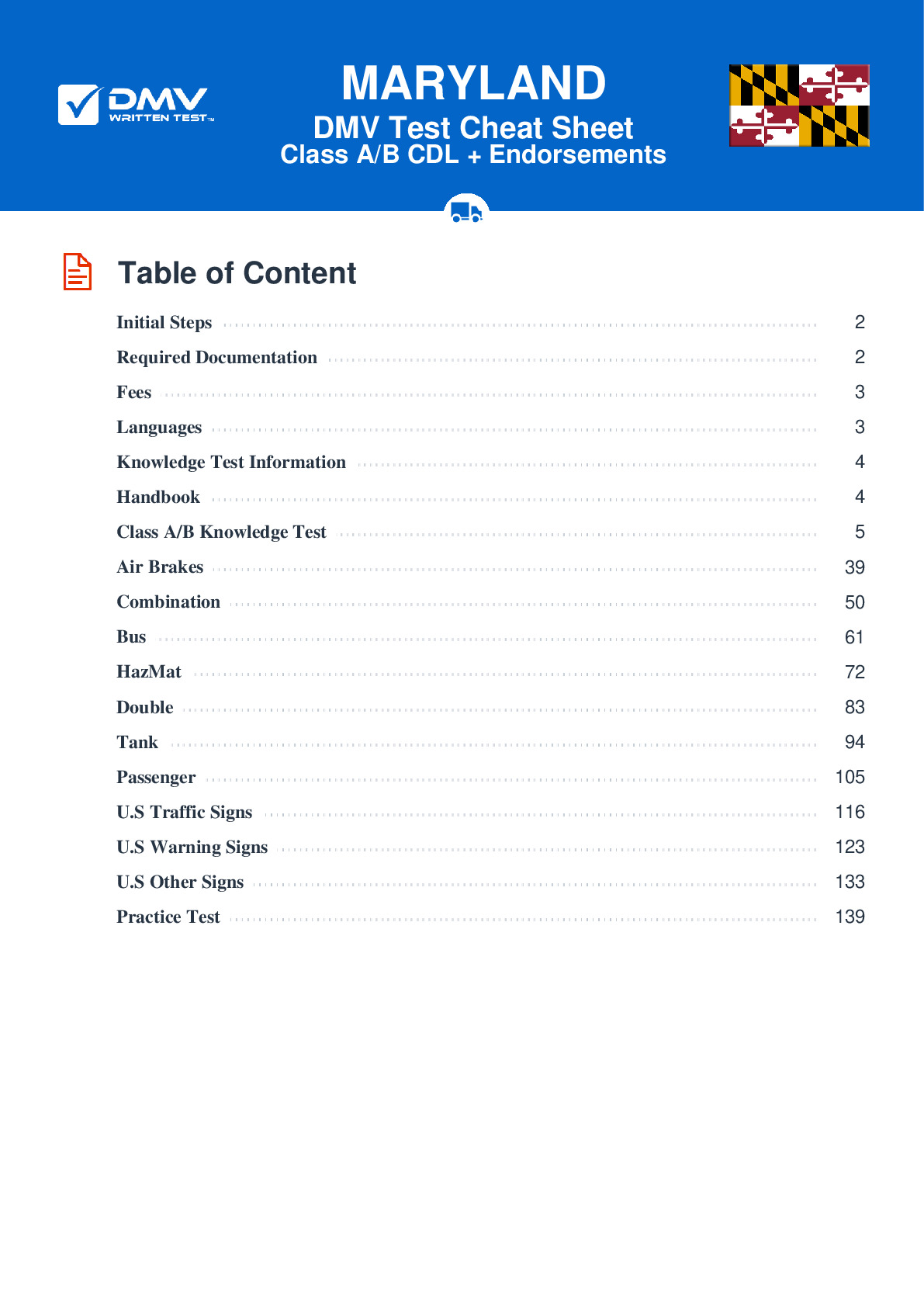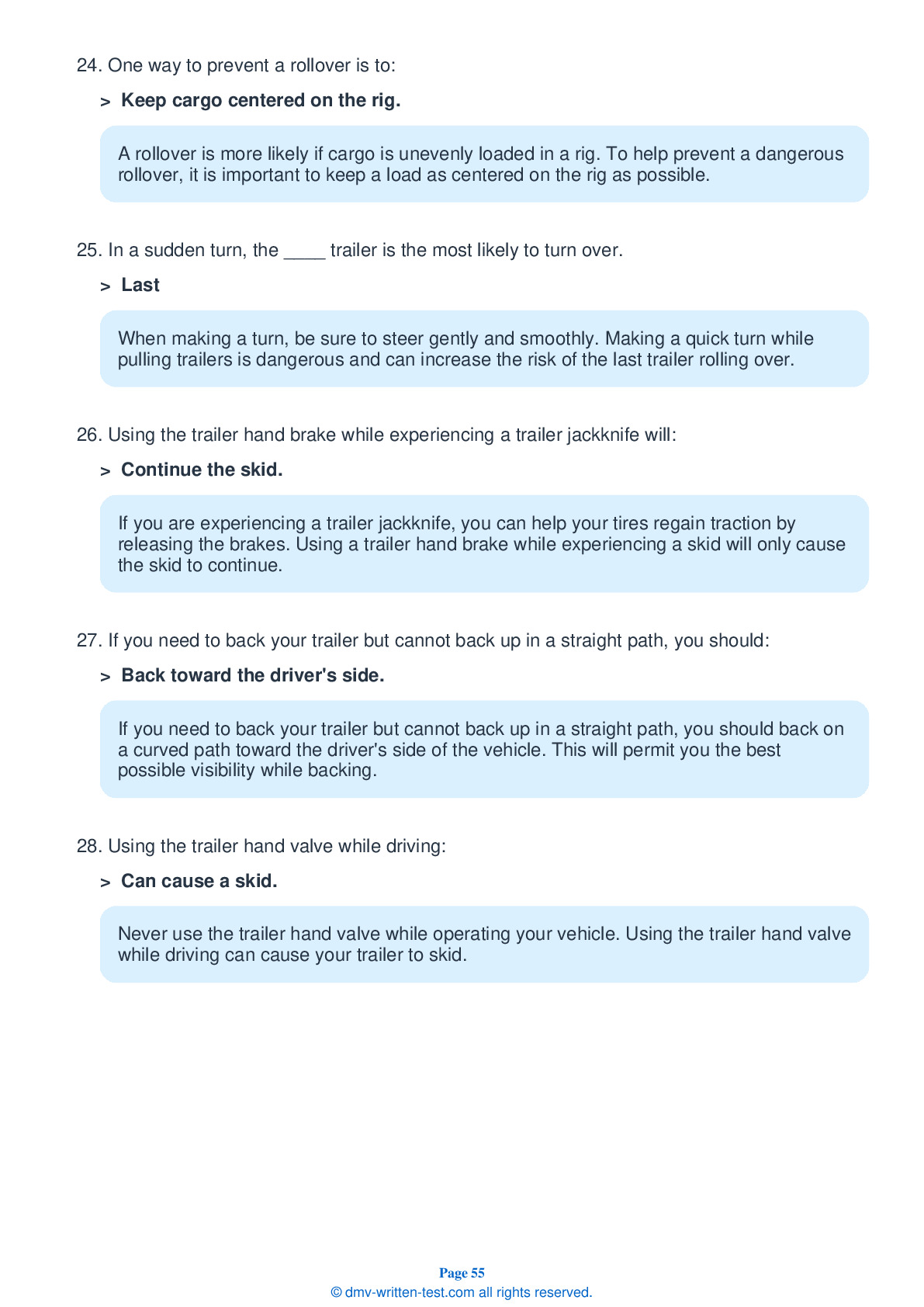Knowledge Test Class B
This license is required for driving a single vehicle with a GVWR of more than 26,001 pounds, and a trailer not to exceed 10,000 pounds gross vehicle weight rating, or a vehicle designed to transport 24 or more people (including the driver). To receive this license, applicants must pass a 50-question test. To pass, applicants must answer 40 questions correctly. Each question has three or four possible answer choices. Test questions come from the Maryland Commercial Driver License Manual. Questions come from chapters covering: Introduction, Driving Safely, Transporting Cargo Safely, Air Brakes (if applicable), Pre-Trip Vehicle Inspection Test, Basic Vehicle Control Skills Test and On-Road Driving.. Endorsements that may be used with a Class B CDL are: Hazardous materials, Tank, Passenger, HazMat and Tank, Air Brakes and School bus.
1. An empty truck:
Empty trucks require longer stopping distances than full trucks because they have less traction available.
2. When checking the power steering fluid during a vehicle inspection, you will need to do each of the following, except:
When checking the power steering fluid during the vehicle inspection test, you must be able to indicate where the power steering fluid dipstick is located and show that there is an adequate amount of power steering fluid in the engine compartment. The fluid level must be above the refill mark.
3. A steering wheel should be held:
A steering wheel should be held firmly with both hands, positioned on opposite sides of the wheel.
4. When leaving your vehicle, you should:
You should always apply the parking brake when leaving your vehicle.
5. Which of the following is not part of a vehicle’s air brake system?
Components of an air brake system include an air compressor, an air compressor governor, air storage tanks, air tank drains, an alcohol evaporator, a safety valve, a brake pedal, foundation brakes, supply pressure gauges, an application pressure gauge, a low air pressure warning signal, a stop light switch, a front brake limiting valve (on some older vehicles), spring brakes, and parking brake controls.
6. How much water needs to be on the surface of a road for a vehicle to hydroplane?
Hydroplaning is an effect in which a vehicle's tires lose traction with the surface of the road and instead glide along a layer of water. There does not have to be much water on the road for this to occur.
7. If hydraulic brakes fail, a driver can reduce their speed by:
If your hydraulic bakes fail, shifting into a lower gear can help slow your vehicle down.
Frequently Asked Questions
To obtain a Class B CDL in Maryland, you must pass a series of knowledge and skills tests, including a general knowledge test and a skills test in the specific type of vehicle you wish to operate. You must also meet certain medical and age requirements, as well as provide proof of identity and residency in Maryland. Additionally, you may need to obtain additional endorsements for certain types of vehicles or cargo, such as passenger transport or hazardous materials transport.
Some examples of vehicles you can operate with a Class B CDL include:
- Straight trucks (e.g. delivery trucks, dump trucks)
- Large buses (e.g. school buses, city buses)
- Box trucks with attached trailers
- Tow trucks with heavy loads
- Cement mixers
- Fire engines
It's important to note that if you want to operate certain types of vehicles or haul certain types of cargo (such as hazardous materials), you may need to obtain additional endorsements on your Class B CDL license.
1. Age: You must be at least 18 years old to operate a commercial vehicle within the state of Maryland, and 21 years old to transport hazardous materials or operate a commercial vehicle across state lines.
2. Medical requirements: You must meet the medical requirements set by the Federal Motor Carrier Safety Administration (FMCSA) to ensure that you are physically qualified to operate a commercial vehicle.
3. Knowledge tests: You must pass a general knowledge test and any additional tests for endorsements you may need, such as passenger or hazardous materials endorsements.
4. Skills test: You must pass a skills test in the specific type of vehicle you wish to operate, which includes a pre-trip inspection, basic control skills, and an on-road driving test.
5. Vision requirements: You must have at least 20/40 vision in each eye (with or without correction), and have a 70-degree field of vision in each eye.
6. Identity and residency: You must provide proof of identity and residency in Maryland.
7. Driving record: You must have a clean driving record with no serious traffic violations or suspensions within the past two years.
It's important to note that the process for obtaining a Class B CDL can vary depending on your individual circumstances, such as whether you have prior driving experience or need additional endorsements for specific types of vehicles or cargo.
Here are the common endorsements for a Class B CDL:
1. Passenger endorsement (P): If you plan to drive a vehicle designed to transport 16 or more passengers, including the driver, you will need to obtain a passenger endorsement.
2. School bus endorsement (S): If you plan to drive a school bus, you will need to obtain a school bus endorsement.
3. Tank vehicle endorsement (N): If you plan to transport liquids or gases in bulk containers with a capacity of 1,000 gallons or more, you will need to obtain a tank vehicle endorsement.
4. Hazardous materials endorsement (H): If you plan to transport hazardous materials, as defined by the Federal Motor Carrier Safety Administration (FMCSA), you will need to obtain a hazardous materials endorsement.
It's important to note that each endorsement requires additional testing and fees. You must pass the appropriate knowledge tests and meet other requirements for each endorsement.
1. Pre-trip inspection: You will be required to perform a thorough inspection of your commercial vehicle to ensure that it is safe to drive. You will be tested on your ability to identify potential safety hazards and defects.
2. Basic vehicle control: You will be asked to demonstrate your ability to control the vehicle in various situations, such as backing up, turning, and parking. You will also be tested on your ability to use the vehicle's controls, such as the horn, brakes, and mirrors.
3. Road test: You will be required to drive the commercial vehicle on public roads while being evaluated on your ability to handle traffic, obey traffic laws and signs, and demonstrate safe driving practices. The road test will include a variety of driving situations, such as turning, merging, and navigating intersections.
It's important to note that the Class B CDL Skills Test is a comprehensive evaluation of your driving skills and knowledge. It's essential that you prepare adequately for the exam by studying the Maryland CDL manual and practicing with a qualified instructor or experienced driver.
1. Air brakes restriction: If you took the skills test in a vehicle without air brakes, you will be restricted to driving commercial vehicles without air brakes. If you want to remove this restriction, you will need to pass the air brakes knowledge test and skills test.
2. Lifting device restriction: If you took the skills test in a vehicle with a lifting device, such as a crane or bucket truck, you will be restricted to driving commercial vehicles with a lifting device. If you want to remove this restriction, you will need to pass the appropriate knowledge and skills tests.
3. Automatic transmission restriction: If you took the skills test in a vehicle with an automatic transmission, you will be restricted to driving commercial vehicles with an automatic transmission. If you want to remove this restriction, you will need to take the skills test in a vehicle with a manual transmission.
4. Passenger vehicle endorsement: If you did not pass the passenger endorsement knowledge and skills tests, you will be restricted from driving a commercial vehicle designed to transport 16 or more passengers.
It's important to note that these restrictions and limitations vary depending on your specific situation. Be sure to check with your state's licensing agency for more information on Class B CDL restrictions and limitations.
To request a language other than English for your Class B CDL written test, you will need to indicate your preferred language when you schedule your appointment with the MVA. You can do this online or by calling the MVA's customer service center.
It's important to note that while you can take the written test in a language other than English, you will still need to demonstrate your ability to communicate in English during the skills test. The skills test will require you to communicate with the examiner and understand instructions given in English.
If you have any questions or concerns about taking the Class B CDL written test in a language other than English, contact your local MVA office for more information.
To request accommodations for the Class B CDL written test, you will need to complete an Application for Reasonable Accommodations form and submit it to the MVA. The form is available on the MVA's website and can be submitted online or by mail.
The MVA will review your request and determine what accommodations are appropriate based on your specific needs. Accommodations may include additional time for the test, a reader or scribe, or a separate testing room.
It's important to note that you must submit your request for accommodations at least 30 days before your scheduled test date. This will allow the MVA sufficient time to review your request and make any necessary arrangements.
If you have any questions or concerns about requesting accommodations for the Class B CDL written test, contact your local MVA office for more information.
It's important to note that you are allowed a maximum of three attempts to pass the written test within a one-year period. If you fail the test three times, you will need to wait one year from the date of your first attempt before you can retake the test.
To prepare for the Class B CDL written test, you can study the Maryland Commercial Driver's License Manual, which is available on the Maryland Motor Vehicle Administration (MVA) website. You may also consider taking a practice test to help identify areas where you need additional study.
If you have any questions or concerns about retaking the Class B CDL written test, contact your local MVA office for more information.




